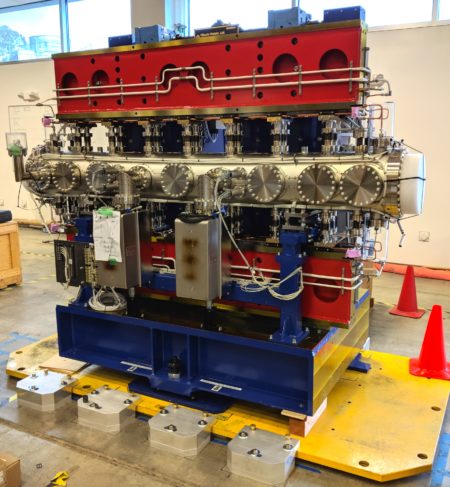
by Ashley White
In Greek mythology, Leda is a Spartan queen and mother of the twins Castor and Pollux. She is often depicted alongside a swan, an allusion to the god Zeus’s guise to seduce her, siring the twins. In reference to the myth, Leda is also the name of the ALS’s recently delivered insertion device—an in-vacuum undulator.
For the next eight months, Leda is taking up residence in the Building 15 high bay, awaiting installation during the January 2019 shutdown. Once commissioned, she’ll produce brilliant beams of x-rays for a protein crystallography beamline under development called Gemini, a reference to Leda and Zeus’s twin sons. (An earlier project to prepare the Sector 2 storage-ring straight section to accommodate Leda was dubbed “Zeus.”)
Undulators employ periodic arrays of permanent magnets to oscillate an electron beam as it passes between them. Each wiggle produces photons; the cumulative product of dozens or even hundreds of periodic wiggles is an intense beam of x-ray light. The properties of the resulting photon beam depend on several parameters, including the period of the magnet spacing and the distance between the top and bottom magnetic arrays, which can be adjusted with a motor. Traditional undulators encase just the electron beam in a vacuum chamber, with magnetic arrays placed above and below the chamber. However, higher fields (and higher photon flux) can be produced when the gap is smaller, which can be accomplished by locating the magnets within the vacuum chamber. But placing the components inside the chamber is no small feat. There are over 1,000 neodymium-iron-boron permanent magnets inside Leda’s vacuum chamber.

“It’s like putting together a ship in a bottle,” said Magnetic Systems Group Leader Chuck Swenson who led the undulator’s specifications and the project work. “You design and build the magnetic structures, and then you have to slide them into the vacuum chamber and figure out how to hold them in place, make your mechanical connections, and align everything in space.”
Leda has a 15 mm period, a 4.3 mm minimum operational gap, and is designed to generate photons between 5–19 keV. The undulator will offer higher photon flux compared to the ALS’s superbend magnet and wiggler sources. It also has the potential to support two branchlines within one hutch (the origin of the beamline’s name of Gemini), and both endstations will be accessible by a single robotic sample mounter, which is being designed now and will be installed in December. The state-of-the-art macromolecular crystallography beamline will feature high flux and high-throughput capabilities designed to enhance productivity. The beamline was designed by ALS Staff Scientist Simon Morton and is primarily funded by the Howard Hughes Medical Institute. It will be operated by the Berkeley Center for Structural Biology under the leadership of Corie Ralston, the center’s head and a staff scientist in Berkeley Lab’s Molecular Biophysics and Integrated Bioimaging Division.

Leda was designed and built over a three-year period by Japan-based Hitachi Metals/Neomax Engineering. After final testing at the SPring-8 synchrotron, she was transported across the Pacific Ocean to California on a ship (the vibrations on an aircraft would pose too high a risk of damaging the brittle magnets). After arriving at Oakland’s port, the 20,000-pound device was brought to Berkeley Lab by truck, where the metal-reinforced wooden crate and packing materials were removed in Building 77 before a forklift carried her to Building 15.
While she’s enjoying her temporary digs in the high bay, she’ll undergo vacuum and magnetic quality assurance tests to validate measurements made in Japan and to ensure no damage occurred during shipping. In January, she’ll be rolled into position next to the storage-ring shield wall, then lifted by crane to her final home in Sector 2. Until then, she is welcoming visitors.
To track the progress of the Gemini beamline project, check out the Berkeley Center for Structural Biology’s Sector 2 news page.